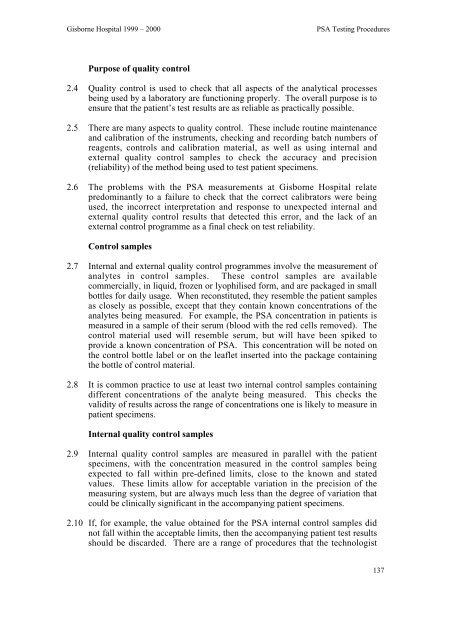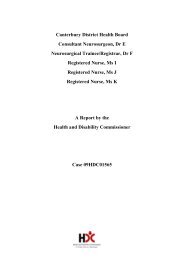Gisborne Hospital Report - Health and Disability Commissioner
Gisborne Hospital Report - Health and Disability Commissioner
Gisborne Hospital Report - Health and Disability Commissioner
Create successful ePaper yourself
Turn your PDF publications into a flip-book with our unique Google optimized e-Paper software.
<strong>Gisborne</strong> <strong>Hospital</strong> 1999 – 2000<br />
PSA Testing Procedures<br />
Purpose of quality control<br />
2.4 Quality control is used to check that all aspects of the analytical processes<br />
being used by a laboratory are functioning properly. The overall purpose is to<br />
ensure that the patient’s test results are as reliable as practically possible.<br />
2.5 There are many aspects to quality control. These include routine maintenance<br />
<strong>and</strong> calibration of the instruments, checking <strong>and</strong> recording batch numbers of<br />
reagents, controls <strong>and</strong> calibration material, as well as using internal <strong>and</strong><br />
external quality control samples to check the accuracy <strong>and</strong> precision<br />
(reliability) of the method being used to test patient specimens.<br />
2.6 The problems with the PSA measurements at <strong>Gisborne</strong> <strong>Hospital</strong> relate<br />
predominantly to a failure to check that the correct calibrators were being<br />
used, the incorrect interpretation <strong>and</strong> response to unexpected internal <strong>and</strong><br />
external quality control results that detected this error, <strong>and</strong> the lack of an<br />
external control programme as a final check on test reliability.<br />
Control samples<br />
2.7 Internal <strong>and</strong> external quality control programmes involve the measurement of<br />
analytes in control samples. These control samples are available<br />
commercially, in liquid, frozen or lyophilised form, <strong>and</strong> are packaged in small<br />
bottles for daily usage. When reconstituted, they resemble the patient samples<br />
as closely as possible, except that they contain known concentrations of the<br />
analytes being measured. For example, the PSA concentration in patients is<br />
measured in a sample of their serum (blood with the red cells removed). The<br />
control material used will resemble serum, but will have been spiked to<br />
provide a known concentration of PSA. This concentration will be noted on<br />
the control bottle label or on the leaflet inserted into the package containing<br />
the bottle of control material.<br />
2.8 It is common practice to use at least two internal control samples containing<br />
different concentrations of the analyte being measured. This checks the<br />
validity of results across the range of concentrations one is likely to measure in<br />
patient specimens.<br />
Internal quality control samples<br />
2.9 Internal quality control samples are measured in parallel with the patient<br />
specimens, with the concentration measured in the control samples being<br />
expected to fall within pre-defined limits, close to the known <strong>and</strong> stated<br />
values. These limits allow for acceptable variation in the precision of the<br />
measuring system, but are always much less than the degree of variation that<br />
could be clinically significant in the accompanying patient specimens.<br />
2.10 If, for example, the value obtained for the PSA internal control samples did<br />
not fall within the acceptable limits, then the accompanying patient test results<br />
should be discarded. There are a range of procedures that the technologist<br />
137
















